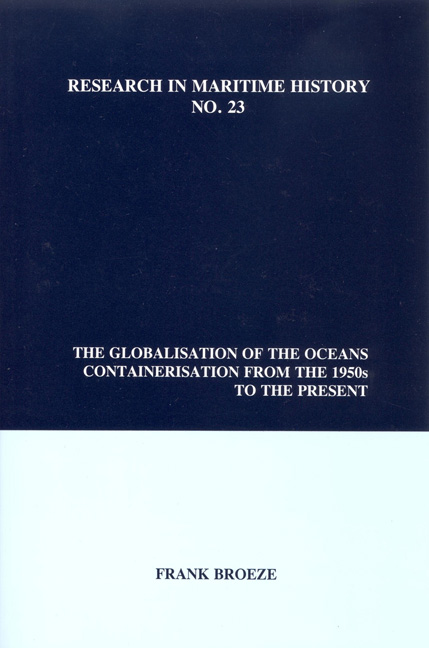Book contents
- Frontmatter
- Table of Contents
- List of Figures
- List of Tables
- Abbreviations
- Acknowledgments
- Preface
- Introduction
- Chapter 1 A Concept and its Realisation
- Chapter 2 The First Revolution
- Chapter 3 The 1970s: Conquering the World
- Chapter 4 The 1980s: Crisis and the Second Revolution
- Chapter 5 The 1990s: Globalisation
- Chapter 6 Ports, Port Systems and Liner Networks
- Chapter 7 Maritime Labour
- Chapter 8 Culture, the Environment and Recycling
- Conclusion
- Select Bibliography
Chapter 7 - Maritime Labour
- Frontmatter
- Table of Contents
- List of Figures
- List of Tables
- Abbreviations
- Acknowledgments
- Preface
- Introduction
- Chapter 1 A Concept and its Realisation
- Chapter 2 The First Revolution
- Chapter 3 The 1970s: Conquering the World
- Chapter 4 The 1980s: Crisis and the Second Revolution
- Chapter 5 The 1990s: Globalisation
- Chapter 6 Ports, Port Systems and Liner Networks
- Chapter 7 Maritime Labour
- Chapter 8 Culture, the Environment and Recycling
- Conclusion
- Select Bibliography
Summary
[Quality] is also about a well-motivated crew.
We cannot sit back as if life owed us a living.
The human and social impact of containerisation was no less profound than its physical, commercial and structural effects on liner shipping and ports. On the waterfront, technological change revolutionised the nature of work and cut a swathe through the workforce. As terminals were constructed further out to sea or on green fields, ships, port workers and sailors alike vacated inner-city docks and harbours. Many previously-bustling maritime precincts became derelict zones. From the 1970s, waterfront redevelopment became one of the great challenges to urban planners; poignantly, a number of such projects - such as the Albert Dock in Liverpool and Darling Harbour in Sydney - included maritime museums chronicling the very world containerisation had destroyed.
Aboard ship great changes also took place as crew sizes were sharply reduced, almost irrespective of the tonnage of their vessels, and traditional job demarcations swept aside through multi-skilling. The 6000-TEU Regina Maerskclass ships sail with a crew of no more than fifteen, representing a ton/man ratio of 5000/1 and an investment per seafarer of roughly US $1.7 million. With airconditioned cabins requiring closed doors and port holes, social life aboard ground to an almost complete standstill; ashore very much the same was true as container ships, true to their financial mission, turned around rapidly at terminals often far removed from the former fleshpots of sailortown. But as the global number of seafarers declined through enlargement of scale of the individual ship, work restructuring and cost cutting, their ethnic composition was radically transformed, as seafarers from high-cost regions were increasingly replaced by colleagues from countries with much lower living and wage standards; the same, albeit to a much lesser extent, applied from the 1980s to officers and masters.
In discussing these changes it must be acknowledged that their causes did not always originate within the liner or container industry itself, and that they often were felt in other sectors of the shipping industry as well. The ramifications of economies of scale, for example, were already being felt aboard and in the handling of bulk carriers and bulk cargoes, while the meteoric rise of the modern flags of convenience after World War II had virtually nothing to do with liner shipping.
- Type
- Chapter
- Information
- The Globalisation of the OceansContainerisation from the 1950s to the Present, pp. 213 - 256Publisher: Liverpool University PressPrint publication year: 2000



